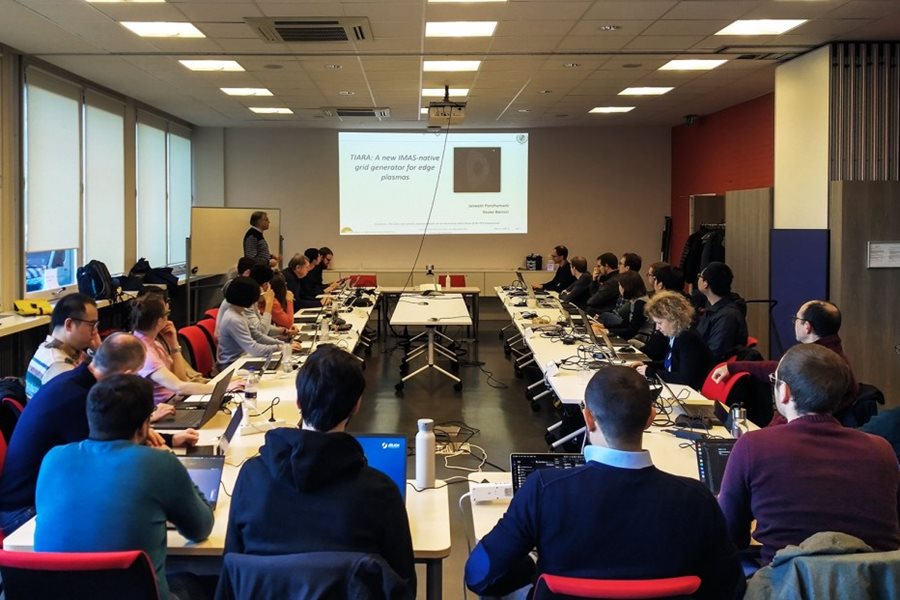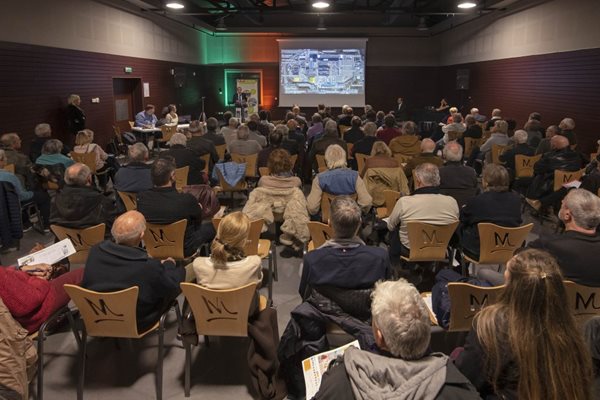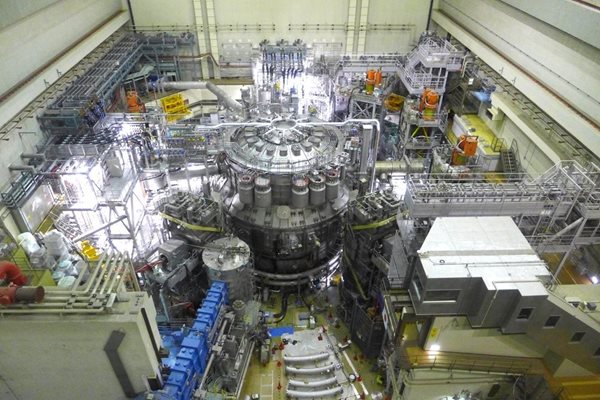
you're currently reading the news digest published from 21 Nov 2022 to 28 Nov 2022
featured3
of-interest1
press36
featured
Plasma modelling | New SOLPS-ITER code version launched
The widely used SOLPS-ITER tool for plasma edge modelling has evolved since its launch in 2015. At recent workshop at KU Leuven in Belgium, European specialists had a chance to discover the code's new capabilities first hand; other workshops are planned to introduce the new version of the code to researchers in the United States and Asia. Like with so many other physical systems, what happens at the boundary of tokamak plasmas is critically determinant to their overall behaviour. For fusion plasmas like those envisaged in ITER, two boundaries are of special interest. The first is the last closed flux surface, or separatrix, which encloses the magnetically confined plasma. The second is the vacuum vessel wall and its material surfaces. Plasma that leaks out of the separatrix is carried on the open magnetic field lines to meet these material surfaces. The divertor at the bottom of the machine is designed to be the place where most of these interactions take place, and the magnetic field lines direct the plasma to that region. The region between the separatrix and the divertor is called the scrape-off layer (SOL). Understanding and controlling the plasma behaviour in the SOL and the divertor regions has been a major focus of fusion research for many decades. In particular, various computational tools have been developed over the years to model these plasmas and improve our knowledge of them. One such modelling tool is the SOLPS-ITER code suite. The SOLPS (Scrape-Off Layer Plasma Simulation) code grew, in the mid-1990s, from the union of the B2 (later B2.5) plasma fluid solver and the EIRENE Monte-Carlo kinetic code for neutral particle transport, which had both originally and independently been developed in the 1980s. It became the main workhorse for ITER simulations during the divertor design phase. In the process, it also attracted a wide user base worldwide, and different research groups furthered the code development in different directions. In the mid-2010s, the ITER Organization took the initiative to regroup all the various code developments into a single common version, named SOLPS-ITER, which was launched in 2015. The ITER Organization manages and freely distributes the SOLPS-ITER code suite to fusion research institutional partners within the ITER Member states. With that support structure in place, the code is now one of the most common SOL plasma simulation tools in use across the ITER Members. Of course, the code is not static, and the ITER Organization and many other research groups continue to advance its physics model and improve its numerical abilities. Indeed, one of the major limitations of SOLPS-ITER was that its plasma computational domain was limited in the SOL to magnetic field lines that start and end on a divertor structure, and thus could not properly take into account some important phenomena occurring at places where the plasma particles encounter other solid structures in the main vacuum vessel. Starting in 2017, a consortium led by Wouter Dekeyser (KU Leuven, Belgium) and Vladimir Rozhansky (Peter the Great St. Petersburg Polytechnical State University, Russia)—both current members of the ITER Scientist Fellow Network—was charged under an ITER contract with the challenging task of extending the code beyond that limit, to be able to model the full vacuum vessel cross-section. After two years of intensive work, and a near-complete rewrite of the code base, this goal was achieved. As many in the plasma edge physics community were eagerly awaiting this new code capability, a series of workshops for users was planned, originally intended to start in the fall of 2020. However, as we all know, travel restrictions were imposed that year and the events were postponed until this year, when it again become possible to assemble in person. The first such workshop was held the week of 14-18 November on the campus of KU-Leuven, under the tutelage of EUROfusion. It gathered some 20+ code users from various EUROfusion labs, in addition to the local KU-Leuven development team and an ITER representative. During the very intense, weeklong workshop, attendees were given presentations detailing how the wide-grids code capabilities have been implemented. They learned how to activate the new code options with some prepared tutorials, and then applied these new skills to cases relevant to their own research interests. Attendees were shown how to use the grid generators CARRE2 and TIARA in their case build-up chain. Other presentations and hands-on sessions focused on new physics capabilities that the KU Leuven team has been implementing in SOLPS-ITER more recently, such as new schemes to better treat the neutral species in the plasma, tools for error quantification and optimization of matches with experimental data, and an extension to the physics model to better reflect the turbulent nature of the plasma transport. Looking into the future, a new grid optimization scheme was presented. Finally a panel discussion on how SOLPS-ITER could be further improved took place, which will form the basis for code development activities planned next year. Two more workshops are currently planned—one to be held this December for US colleagues at the University of Tennessee Knoxville campus, co-sponsored with Oak Ridge National Laboratory and the US Department of Energy, and another one in Asia in 2023 to facilitate the participation of researchers from the ITER Members in this geographical area. For further information, please contact xavier.bonnin@iter.org.
Open Doors Day | Accessing the very heart of ITER
Small or tall, knowledgeable or neophyte, from near or far ... the 600 people who took part in ITER's latest Open Doors Day all departed with the sense that something consequential is happening in this rural corner of southern France. First, it's the size. From the pieces of the ITER machine that are viewable in different stages of handling and assembly, to the concrete and steel buildings that house them, touring ITER makes you feel like you may have crossed through a looking glass and woken up in a different world, where your usual vocabulary is simply inadequate. Then, it's the aspiration. Pushing to leave behind yesterday's boundaries in science and technology to achieve something remarkable in the domain of energy, with all of the challenges that have been solved and those that remain, and all that is being learned along the way. And finally, the team. Your guide may have been Slovene, Chinese, or American; your expert Indian, Dutch or French. Listening to them speak with passion about their slice of the project, sharing something of their expertise and experience, and breaking down complex notions into ingestible pieces, really reinforces the sense that the effort to demonstrate the feasibility of fusion is broad, the stakes universal, and the solution international. Here are more scenes from the Open Doors Day on 26 November.
Local | A question and answer session
Nuclear safety policy in France requires that a local information commission (Commission locale d'information, CLI) be established every time a nuclear installation is created. A CLI is an independent body that acts as an interface between the installation's operator and the local population. It is composed of representatives from local government, environmental groups, trade unions, businesses and health professionals. Anything that the public feels it should know falls under the jurisdiction of the CLI. A CLI can request from the operator any documents deemed necessary, or call on independent laboratories to proceed with environmental and health investigations. The CLI must be consulted on any new project undertaken in the scope of the installation's evolution. In addition to its day-to-day actions, the ITER CLI (now merged with that of neighbouring CEA-Cadarache) organizes an annual public meeting where the ITER management, along with representatives of the French nuclear safety authority (ASN) and local labour and occupational health departments are invited to present and discuss pending issues. This year's annual meeting was held on Thursday 24 November in Manosque (where a large proportion of ITER staff reside) and provided the new ITER Director-General, Pietro Barabaschi, with his first opportunity to interact with the local public, media and authorities. Questions from the public focused on construction and manufacturing status, economic benefits for local companies, and the impact that necessary component repair will have on the project's overall progress. Of all the questions asked, only this last one could not be answered with precision, as repair strategies are presently being explored, and impact on schedule and cost will only be determined once a specific strategy has been chosen.
of-interest
Following repairs, JT-60SA commissioning to restart in 2023
The JT-60SA tokamak—a joint program of fusion research and development agreed and co-financed by the European Atomic Energy Community (Euratom) and the government of Japan—could restart cooldown operations and coil energization as early as March 2023, according to an article published by Fusion for Energy (Barcelona), the implementing agency for Euratom. In 2021, a short circuit at the terminals of one of the machine's largest poloidal field coils had necessitated a pause in commissioning and a thorough assessment and analysis. One year of repair and further testing is now behind the joint Japan-Europe team, and plans are being laid for the restart of commissioning and possible first plasma next year. See the full report on the Fusion for Energy website.



